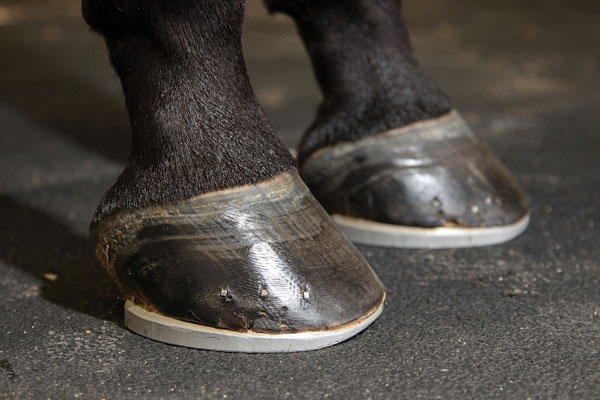You’ve almost certainly heard the phrase, “no hoof, no horse.” While feet might not be the most exciting aspect of horse ownership to discuss, they’re certainly the foundation of success—both figuratively and literally.
At my barn, we pay close attention to shoeing, trimming, and hoof care. I attribute our infrequent incidence of lower-leg problems—pulled and torn tendons and ligaments—to taking special care to tailor-make a hoof-care program for each horse, according to his needs. I’ll share a few of our practices here so you can consider how they might work in your situation and discuss them with your farrier.
There are three things I want to make clear to start. 1.) I’m not a farrier; I use the services of a highly skilled professional, and we discuss my horses’ feet and the best course of action for each horse. 2.) Successful hoof care is highly individualized—every horse has different needs depending on his job, his living situation, and the ground conditions where he lives and works. 3.) My horses are shod and trimmed for Western performance events that take place in an arena. Your discipline might have different needs to consider.
Barefoot Can Be Better
The longer I can have horses barefoot, at least in the front, the better their feet tend to be. We don’t encounter the contracted heels that you see on some shod feet (especially those that are shod too tight; I’ll discuss that later). The feet you see in the top photo on this page belong to a 6-year-old mare that’s been shown to success and has competed at the AQHA World Show. She has shoes on her hind feet, but we’ll keep her barefoot in front until her feet or the conditions necessitate a change.


Once you put shoes on, it’s harder for performance horses to go back to bare feet. We have two mares in the barn that we’re taking back to bare in the front. Their hooves will chip, but they’re rasped weekly to maintain their shape while letting their hooves grow.
The kicker is that you must live in an area that accommodates bare feet. We have very sandy ground in and around our arenas, and we keep it immaculately maintained. The fields and roads surrounding our place are also fairly sandy. If our horses were on rockier, harder ground, we likely couldn’t keep them barefoot. But in our conditions it works for our horses.
Keep Shoeing as Simple as Possible
The mare’s feet in the bottom photo on this page are normal. She had shoes on when the photo was taken because we’d hauled her to a place with poor ground that wasn’t suitable for bare feet. Even with shoes, her feet have nice shape and length.

One common mistake that can negatively influence even a simple shoe set like this involves shoeing too tightly. Sometimes the foot is made to fit the shoe rather than vice versa. This can lead to contracted heels, which cause serious problems for a horse’s soundness. A foot needs room to expand on the shoe. In my program, we put a shoe on so that you can run a felt-tip pen around the edge of the shoe—there’s just a slight lip, only enough to see a difference but not so much to interfere with movement. This leaves the horse’s feet room to grow on the shoe rather than the shoe contracting the foot as it gets longer.
Because my horses do arena work, we’re able to use fewer nails to attach a shoe. Horses with more intense jobs, such as riding over rough terrain, might require more nails to keep a shoe on. But I find that fewer nails work on my horses, and it allows room for the heel to expand, further preventing contracted heels.
Use Correction When Necessary
Even when it comes to correctional shoeing, I like to keep it simple. The gelding’s feet pictured on this page were big, flat platters when he came to our barn. His feet were so spread out that he’d step on himself all of the time. His aluminum wedge shoes slightly raise his heels and keep his hooves in a better shape.
The improved shape and slightly raised heel are essential for performance and soundness. Interfering, poorly shaped feet clip each other and can lead to superficial lower-leg injuries that require time off to heal properly. More importantly, raised heels reduce the pressure placed on the lower legs’ tendons and ligaments. I have very few lower-leg soundness problems, thanks to paying close attention to my horses’ heels.
Shoe for the Job
My farrier understands my horses’ jobs. He’s well educated in his trade, and he works on elite horses to keep their feet in the best condition possible. His knowledge combined with my experience make for the best outcome for each horse.

If you specialize in a performance event, find a farrier who understands your discipline. His knowledge will enhance your horse’s ability to perform, helping you reach a higher level of success. If you live in difficult conditions or travel over rocky, rough ground while trail riding, be sure that your shoer understands those elements. Then he can help you set your horse up for comfort and soundness so you don’t lose riding time while your horse is laid up with an injury.






